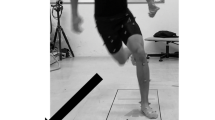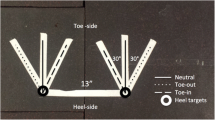Abstract
Purpose
Explore whether dorsiflexion range of motion (ROM) influences cutting kinematics.
Methods
Dorsiflexion ROM was measured in 42 individuals using the weight-bearing lunge test (WBLT). Unanticipated cutting kinematics were collected at initial contact (IC) and between IC and maximum knee flexion using three-dimensional motion and inertial measurement unit methods. Multiple linear regressions with sex as a confounder were used to explore the relationship between kinematic variables and WBLT dorsiflexion ROM for both legs.
Results
WBLT dorsiflexion ROM values were 51.33 ± 6.48° and 50.21 ± 7.00° on dominant and non-dominant legs, respectively. For dominant leg cutting, transverse plane knee ROM increased 0.20° (p = 0.037), sagittal plane trunk ROM increased 0.16° (p = 0.044), and trunk flexion at IC decreased 0.39° (p = 0.009) for each degree of WBLT dorsiflexion ROM measured. Males had 5.89° greater trunk flexion at IC than females. For non-dominant leg cutting, peak lateral trunk flexion towards the stance leg, and sagittal and coronal plane hip ROM increased 0.36° (p = 0.039), 0.24° (p = 0.017), and 0.21° (p = 0.005) for each degree of dorsiflexion ROM, respectively.
Conclusions
Dorsiflexion ROM influences cutting kinematics and may contribute to anterior cruciate ligament injury.





Similar content being viewed by others
References
Devita P, Skelly WA (1992) Effect of landing stiffness on joint kinetics and energetics in the lower extremity. Med Sci Sports Exerc 24(1):108–115
Hoch MC et al (2015) Weight-bearing dorsiflexion range of motion and landing biomechanics in individuals with chronic ankle instability. J Athl Train 50(8):833–839
Fong C et al (2011) Ankle-dorsiflexion range of motion and landing biomechanics. J Athl Train 46(1):5–10
Mason-Mackay A, Whatman C, Reid D (2017) The effect of reduced ankle dorsiflexion on lower extremity mechanics during landing: a systematic review. J Sci Med Sport 20(5):451–458
Leppänen M et al (2017) Stiff landings are associated with increased ACL injury risk in young female basketball and floorball players. Am J Sports Med 45(2):386–393
Podraza JT, White SC (2010) Effect of knee flexion angle on ground reaction forces, knee moments and muscle co-contraction during an impact-like deceleration landing: implications for the non-contact mechanism of ACL injury. Knee 17(4):291–295
Swenson DM et al (2013) Epidemiology of knee injuries among US high school athletes, 2005/06–2010/11. Med Sci Sports Exerc 45(3):462
Craig CL et al (2003) International physical activity questionnaire: 12-country reliability and validity. Med Sci Sports Exerc 35(8):1381–1395
Powden CJ, Hoch JM, Hoch MC (2015) Reliability and minimal detectable change of the weight-bearing lunge test: a systematic review. Man Ther 20(4):524–532
Hall EA, Docherty CL (2017) Validity of clinical outcome measures to evaluate ankle range of motion during the weight-bearing lunge test. J Sci Med Sport 20(7):618–621
Saunders NA (2006) Characteristics of the female landing pattern. University of Ballarat, Ballarat
Laurent CM et al (2011) A practical approach to monitoring recovery: development of a perceived recovery status scale. J Strength Cond Res 25(3):620–628
Cappozzo A et al (1995) Position and orientation in space of bones during movement: anatomical frame definition and determination. Clin Biomech 10(4):171–178
Gurchiek RD et al (2017) The use of a single inertial sensor to estimate 3-dimensional ground reaction force during accelerative running tasks. J Biomech 61:263–268
Grood ES, Suntay WJ (1983) A joint coordinate system for the clinical description of three-dimensional motions: application to the knee. J Biomech Eng 105(2):136–144
Harry JR et al (2017) Comparison of pre-contact joint kinematics and vertical impulse between vertical jump landings and step-off landings from equal heights. Hum Mov Sci 56:88–97
Benjaminse A et al (2011) What is the true evidence for gender-related differences during plant and cut maneuvers? A systematic review. Knee Surg Sports Traumatol Arthrosc 19(1):42–54
Hewett TE, Torg JS, Boden BP (2009) Video analysis of trunk and knee motion during non-contact anterior cruciate ligament injury in female athletes: lateral trunk and knee abduction motion are combined components of the injury mechanism. Br J Sports Med 43(6):417–422
Sheehan FT, Sipprell WH III, Boden BP (2012) Dynamic sagittal plane trunk control during anterior cruciate ligament injury. Am J Sports Med 40(5):1068–1074
Boden BP et al (2009) Video analysis of anterior cruciate ligament injury: abnormalities in hip and ankle kinematics. Am J Sports Med 37(2):252–259
Hashemi J et al (2011) Hip extension, knee flexion paradox: a new mechanism for non-contact ACL injury. J Biomech 44(4):577–585
Jones PA, Herrington LC, Graham-Smith P (2015) Technique determinants of knee joint loads during cutting in female soccer players. Hum Mov Sci 42:203–211
Chinnasee C et al (2018) A biomechanical comparison of single-leg landing and unplanned sidestepping. Int J Sports Med 39(08):636–645
Kristianslund E, Krosshaug T (2013) Comparison of drop jumps and sport-specific sidestep cutting: implications for anterior cruciate ligament injury risk screening. Am J Sports Med 41(3):684–688
Fung DT, Zhang L-Q (2003) Modeling of ACL impingement against the intercondylar notch. Clin Biomech 18(10):933–941
Shultz SJ, Schmitz RJ (2009) Effects of transverse and frontal plane knee laxity on hip and knee neuromechanics during drop landings. Am J Sports Med 37(9):1821–1830
Booshanam DS et al (2011) Evaluation of posture and pain in persons with benign joint hypermobility syndrome. Rheumatol Int 31(12):1561–1565
Hewett TE, Myer GD (2011) The mechanistic connection between the trunk, knee, and anterior cruciate ligament injury. Exerc Sport Sci Rev 39(4):161–166
Jamison ST, Pan X, Chaudhari AM (2012) Knee moments during run-to-cut maneuvers are associated with lateral trunk positioning. J Biomech 45(11):1881–1885
Bennell K et al (1998) Intra-rater and inter-rater reliability of a weight-bearing lunge measure of ankle dorsiflexion. Aust J Physiotherapy 44(3):175–180
Funding
The authors have no relevant financial or non-financial interests to disclose. The authors did not receive support from any organization for the submitted work.
Author information
Authors and Affiliations
Contributions
All authors contributed to the study conception and design. Material preparation, data collection and analysis were performed by IH, JR and KH-L. The first draft of the manuscript was written by IH and all authors commented on previous versions of the manuscript. All authors read and approved the final manuscript.
Corresponding author
Ethics declarations
Conflict of interest
None.
Ethical approval
A Health Research Ethics Committee approved the study protocol [HREC(Health)2018#27], which adhered to the Declaration of Helsinki.
Informed consent
All participants signed a written informed consent document prior to participating that explained the potential risks associated with testing.
Additional information
Publisher's Note
Springer Nature remains neutral with regard to jurisdictional claims in published maps and institutional affiliations.
Rights and permissions
About this article
Cite this article
Hanzlíková, I., Richards, J. & Hébert-Losier, K. The influence of ankle dorsiflexion range of motion on unanticipated cutting kinematics. Sport Sci Health 18, 1405–1414 (2022). https://doi.org/10.1007/s11332-022-00912-5
Received:
Accepted:
Published:
Issue Date:
DOI: https://doi.org/10.1007/s11332-022-00912-5




